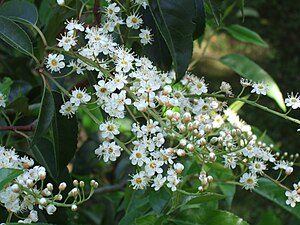Portuguese cherry laurel
| Portuguese laurel cherry | ||||||||||||
|---|---|---|---|---|---|---|---|---|---|---|---|---|

Portuguese laurel cherry ( Prunus lusitanica ) |
||||||||||||
| Systematics | ||||||||||||
|
||||||||||||
| Scientific name | ||||||||||||
| Prunus lusitanica | ||||||||||||
| L. |
The Portuguese cherry laurel ( Prunus lusitanica ), also popularly known as the Portuguese cherry laurel , is a species of the rose family (Rosaceae).
features
The Portuguese laurel cherry is an evergreen tree or shrub that reaches heights of 3 to 8, rarely up to 20 meters. The young twigs and petioles are bare and dark red. The leaves are also glabrous, also glossy dark green, glandless, elongated-lanceolate, arranged in two rows and serrated. The flowers are arranged in rich, upright, protruding clusters . The petals are whitish and 4 to 7 millimeters long. The fruits are black-purple and ovate, pointed.
The flowering time is in June.
Occurrence
The species is found in southern France, the Iberian Peninsula, Morocco and the Canary Islands. Their habitat are moist forests. The stocks in the Canary Islands belong to the subspecies Prunus lusitanica subsp. hixa (Willd.) Franco and grow there in the laurel forest region .
supporting documents
- Ingrid and Peter Schönfelder : Kosmos-Atlas Mediterranean and Canary Islands flora . Franckh-Kosmos Verlag, Stuttgart 1994, ISBN 3-440-06223-6 , p. 70 .